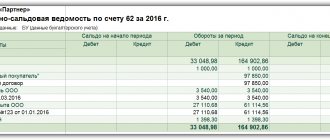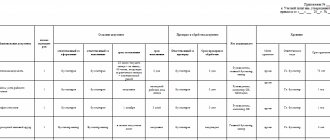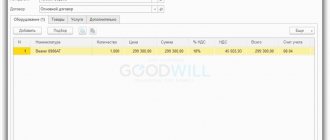In the process of functioning, an economic entity carries out many operations in various areas relating to financial, production, economic, social and other areas of activity. All operations represent a single system that reflects the activity of the subject and is the subject of accounting, which can be defined as the financial and economic activities of an organization, regardless of its form of ownership.
The objects of accounting are economic categories that are directly used in the implementation of activities by an economic entity. Article 5 of the Federal Law “On Accounting” dated December 6, 2011 No. 402-FZ specifies a specific list of those categories that are the object of accounting. In accordance with this legal norm, accounting objects include:
- assets and liabilities,
- facts of economic life,
- income and expenses,
- sources of financing the entity's activities.
The subject and objects of accounting can be briefly described as:
- subject – financial and economic activity of the subject;
- objects – categories included in the financial and economic activities of the subject.
Accounting methods are the techniques by which a subject is studied. In other words, these are the methods used to study the activities of an economic entity. In this case, the methods can be quantitative and qualitative, allowing for recording, analysis and research of objects.
The essence of accounting objects: definition by the Ministry of Finance
There are quite a few interpretations of the term “accounting objects”. Let's consider its official definition given in paragraph 4 of Order No. 34n of the Ministry of Finance of the Russian Federation dated July 29, 1998.
According to this document, accounting objects should be understood as the property of enterprises, their obligations, as well as business operations carried out in the process of economic activity.
A specific list of accounting objects at the legislative level is determined by the provisions of the Law “On Accounting” dated December 6, 2011 No. 402-FZ.
Outskirts
In accordance with Art. 5 of the Federal Law of December 6, 2011 No. 402-FZ “On Accounting”, the objects of accounting of an economic entity are: facts of economic life; assets; obligations; sources of financing its activities; income; expenses; other objects if this is established by federal standards.
Based on the composition and nature of use, the organization’s property is divided into three groups:
- non-current assets: fixed assets (buildings, machinery, structures, equipment, vehicles, inventory), intangible assets, capital investments, long-term financial investments;
- current assets: short-term financial investments (raw materials, fuel, semi-finished products, finished products, funds in settlements, etc.);
- diverted funds (taxes and other payments from profits to the budget, etc.).
According to their purpose, documents are divided into:
- for administrative ones: powers of attorney, orders, orders. Administrative documents do not serve as a basis for recording in accounting registers. They are of great importance for preliminary control of correctness, i.e. legal and economic feasibility of transactions;
- vouchers: receipt and expense invoices, various acts, cash receipts, etc.;
- accounting registration: payroll statements, calculation of depreciation deductions, certificates of errors found in accounting registers and to be corrected through additional entries, etc.;
- combined: invoices and requirements for receiving materials from the warehouse have administrative and justifying purposes.
According to the method of reflecting business transactions, documents are divided:
- on primary documents compiled in the process of performing a particular operation. They become the very first written evidence of its implementation, for example, cash orders, payment orders, invoices, acceptance certificates, transmittal sheets for the amount of cash receipts, etc.
Depending on the number of registered transactions, primary documents are divided:
- for one-time documents - documents (cash order, check, demand, invoice) that record a single, one-time transaction;
- cumulative documents that reflect several homogeneous business transactions as they are completed over a certain period of time;
- summary documents. This is the first stage of summarizing the information contained in several primary documents, which precedes their accounting processing. Consolidated documents are commodity reports of materially responsible persons, cash reports of the cashier, reports of accountable persons on their expenditure of cash advance.
What are the objects of accounting?
In accordance with the provisions of Art. 5 of Law No. 402-FZ, accounting objects are :
- facts of the economic life of the enterprise;
- assets and liabilities of the enterprise;
- sources of financing;
- income and expenses of the company;
- other objects specified by federal legislation.
A fact of economic life should be understood as any transaction, operation or other significant event that has or could potentially have an impact on the financial condition of the enterprise, the results of its activities or the flow of capital (Article 3 of Law No. 402-FZ).
A company's assets and liabilities can be presented in a wide range of varieties: their correct classification can be important when drawing up a balance sheet - one of the key sources of financial statements.
This classification can be studied in detail by reading the provisions of Section IV of Order of the Ministry of Finance of the Russian Federation dated July 6, 1999 No. 43n (PBU 4/99).
Sources of financing the company's activities can be represented by:
- authorized capital;
- income (including revenue);
- credit funds;
- investments;
- budget revenues.
In accordance with paragraph 2 of PBU 9/99, income should be understood as an increase in the economic benefits of the enterprise not caused by the actions of the founders (owners):
- receipt of assets (in the form of cash or other property);
- repayment of obligations, as a result of which the capital of the enterprise increases.
In accordance with paragraph 2 of PBU 10/99, expenses should be understood as a reduction in the economic benefits of the enterprise not caused by the actions of the founders (owners):
- disposal of assets;
- the emergence of obligations that lead to a decrease in the capital of the enterprise.
Assets, Liabilities and Sources of Funding
Definition 1
Assets are the property or resources of an enterprise that it owns and manages to carry out its activities in order to achieve the goal of making a profit. Considering the principles of Russian accounting, we are talking only about assets that belong to the enterprise as a property.
Liabilities are the debt of an enterprise to its counterparties and creditors, which must be repaid by a certain period of time.
The main difference between these concepts is that assets imply the inflow of funds, and liabilities imply their outflow. Depending on the urgency of circulation, assets and liabilities are classified into short-term, up to 12 months, and long-term, more than a year. The dependence of obligations on ownership divides them into own and borrowed. Assets and liabilities are reflected in the balance sheet of the enterprise.
Have questions about this topic? Ask a question to the teacher and get an answer in 15 minutes! Ask a Question
Sources of financing the activities of an enterprise are the very first financial resources from which the formation of the enterprise itself begins; they are necessary initially for the creation, and subsequently for its existence and functioning. Subsequently, they are the subject of innovative development and investment.
There are many classifications - we list the main types of sources of financing: external, internal, attracted, borrowed, short-term and long-term. Balances in bank accounts or in the cash register of an enterprise as of a certain date are a monetary form of expression of the company’s financial resources.
Valuation of accounting objects as a necessary condition for accounting procedures
The most important operation performed within the framework of accounting with accounting objects is their evaluation. It is a procedure, the result of which is the reflection of the cost of an object in rubles (Article 12 of Law 402-FZ).
The need for assessment arises due to the fact that all information about the noted accounting objects is reflected in accounting documents, as well as in reporting, in monetary terms.
The basic principles by which the value of accounting objects should be assessed are enshrined in clause 23 of Order No. 34n of the Ministry of Finance of the Russian Federation dated July 29, 1998, as well as in PBUs regulating the features of accounting for certain accounting objects.
Sources of resource formation
All sources available in an LLC can be divided between two groups - equity and borrowed capital. Own capital includes:
- The authorized capital of the company, formed at the initial stage of formation of the LLC, this capital is made up of the founders;
- Reserve capital - is formed by the LLC by deducting a share of retained earnings, the created reserve allows you to cover the annual losses of the LLC;
- Additional capital - is formed based on the results of revaluation by increasing the value of the assets being valued;
- Profit not distributed at the end of the year, or loss not covered.
Borrowed capital includes:
- Borrowed funds – long-term and short-term loans taken by the LLC to carry out its activities;
- Accounts payable are funds that an LLC owes to its counterparties, employees, budget, and funds.
Results
Accounting, like any other areas of activity related to the management of an organization, has objects. Their essence is defined at the legislative level - in Law No. 402-FZ, as well as in the provisions of Order No. 34n of the Ministry of Finance.
You can find other useful information about accounting in the following articles:
- “Accounting in 2015–2016 (chart of accounts and principles)”;
- "Accounting in budgetary institutions."
You can find more complete information on the topic in ConsultantPlus. Free trial access to the system for 2 days.
Income and expenses
Note 1
Income and expenses of an enterprise are the most complex and controversial aspect in accounting and tax accounting. After all, it is the rules and principles of their accounting and reflection in the system that determine the financial result of the entire enterprise, and ultimately the amount of money flowing into the state budgets. The difference between these accounting elements forms profit, the main economic goal of the creation and existence of an economic entity.
Income – an increase in benefits as a result of the receipt of assets. Consumption is, accordingly, the opposite. Income, like expenses, have a general classification; they are divided according to sources of formation into income and expenses:
- From ordinary activities – revenue for income; expenses include costs related to ordinary, main activities in the production of goods, provision of work, services
- Operating - from the sale of property, and interest from the use, provision of loans, credits; funds for patents, intellectual property
- Non-sales – fines, penalties for failure to comply with the terms of contracts; losses and profits of previous years; gratuitous receipt/transfer of an asset
- Emergency – elements of economic activity that arose as a result of extraordinary circumstances (natural disasters, fire, accidents.
Do you need to select scientific articles for your academic work? Specify a topic and receive a response in 15 minutes get help
Household supplies
Household assets are the main objects of accounting. They are divided into negotiable and non-current.
- Working capital forms the capital of the company. These include: materials, fuels and lubricants, parts, semi-finished products, work in progress. What these resources have in common is that they are completely consumed in one production cycle. The cost at which they are recorded is fully included in the cost of manufactured goods.
- Non-current assets form the fixed capital of the company. Their main difference is that they can be used in production repeatedly over a long period of time. Their cost is transferred to the cost of manufactured goods gradually. These include: special equipment, transport, real estate.






